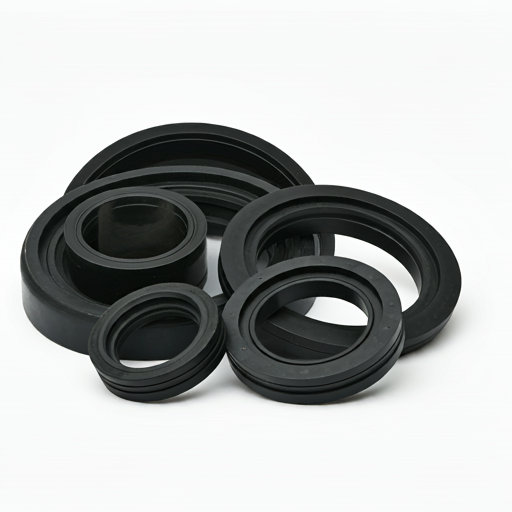Ethylene Propylene Diene Monomer (EPDM) rubber is a versatile synthetic elastomer widely used across various industries due to its unique properties. One critical characteristic influencing its application is material density. This article delves into the density of EPDM rubber, its implications in different applications, and how it can solve specific industry challenges.
What is EPDM Rubber?
EPDM rubber is a thermoset elastomer characterized by its saturated polymer backbone, which provides superior resistance to heat, ozone, and weathering compared to unsaturated rubbers like natural rubber or styrene-butadiene rubber (SBR). The composition of EPDM includes ethylene, propylene, and a diene component that allows for crosslinking during the vulcanization process, enhancing its mechanical properties.

Density of EPDM Rubber
The density of solid EPDM rubber parts typically ranges from 0.86 to 0.92 grams per cubic centimeter (g/cm³). This range can vary based on several factors:
- Composition: Different formulations of EPDM, including varying ratios of ethylene, propylene, and diene, can affect density.
- Additives and Fillers: The inclusion of fillers (such as carbon black or silica) can increase the density of the rubber parts.
- Manufacturing Process: The processing methods used to create the solid parts can also influence their final density.
For specific applications, it’s essential to consult technical data sheets from suppliers for the exact density of the EPDM formulation being used.
| Type of EPDM Rubber | Density (g/cm³) | Key Properties | Common Applications |
|---|---|---|---|
| Solid EPDM | 0.86 - 0.92 | High durability, excellent sealing | Automotive seals, gaskets |
| Closed Cell Sponge EPDM | 0.15 - 0.30 | Lightweight, flexible | Insulation, cushioning |
| Expanded EPDM Sponge | 0.07 - 0.33 | Vibration dampening | HVAC systems, packaging |
Also,The curing process can influence the final density based on the formulation and curing method:
| Curing Method | Density (g/cm³) | Key Features | Common Applications |
|---|---|---|---|
| Sulfur-Cured EPDM | 1.0 - 1.3 | Standard density, good mechanical properties | Automotive seals, hoses, gaskets |
| Peroxide-Cured EPDM | 1.0 - 1.22 | Higher heat resistance, better compression set | Wire insulation, high-temperature seals |
| Resin-Cured EPDM | 0.90 - 1.10 | Increased density due to additives, hard surface | Industrial belts, high-strength seals |
| Foamed (Expanded) EPDM | 0.07 - 0.33 | Lightweight, low density, flexible | HVAC systems, vibration dampening, packaging |
- Sulfur-Cured EPDM: The most common type, with a typical density range and strong general mechanical properties.
- Peroxide-Cured EPDM: Similar density to sulfur-cured, but with enhanced heat resistance and improved compression set, making it suitable for high-temperature environments.
- Resin-Cured EPDM: May have a slightly higher density due to resin additives, resulting in a harder and more rigid material.
- Foamed EPDM: The lowest density, due to the expansion process creating a sponge-like material for lightweight applications.
Importance of Density in Applications
The density of EPDM rubber significantly influences its performance in various applications:
- Sealing Applications: Higher density solid EPDM is preferred for sealing joints in automotive and construction industries due to its superior airtight sealing performance, which blocks wind, noise, and dust.
- Insulation: Lower-density sponge variants are utilized in insulation materials where lightweight and flexibility are paramount. They provide effective thermal insulation while being easy to handle.
- Automotive Uses: In the automotive sector, EPDM's density contributes to the overall weight management of vehicles while ensuring durability against environmental factors like UV exposure and extreme temperatures.
Industry-Specific Applications
- Construction: Used as weather stripping and roofing membranes due to its weather resistance and flexibility.
- Automotive: Essential for door seals and window gaskets that require high durability and resistance to environmental degradation.
- Electrical Insulation: Its low density coupled with good electrical insulating properties makes it suitable for high-voltage cable insulation.
Choosing the Right Density for Your Needs
When selecting an EPDM product, consider the following factors:
- Application Requirements: Determine if your application requires high durability or lightweight materials.
- Environmental Conditions: Assess exposure to UV light, temperature extremes, or chemical interactions.
- Performance Standards: Ensure that the chosen density meets industry standards for tensile strength, elongation, and compression set.
Conclusion
Understanding the density of EPDM rubber is crucial for selecting the right material for your specific needs. Whether you require a high-density solid for robust sealing or a low-density sponge for insulation, EPDM offers a range of options tailored to various industrial applications. For customized solutions or inquiries about our EPDM rubber products, please contact us today! Our expert team is ready to assist you in finding the perfect material that meets your specifications while ensuring quality and performance.







